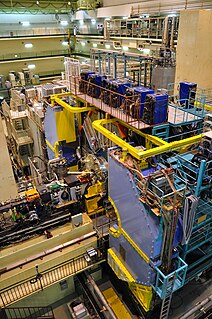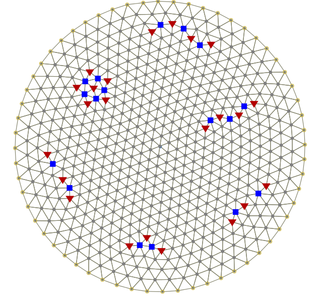
A tetraquark, in particle physics, is an exotic meson composed of four valence quarks. A tetraquark state has long been suspected to be allowed by quantum chromodynamics, the modern theory of strong interactions. A tetraquark state is an example of an exotic hadron which lies outside the conventional quark model classification.

Jack Steinberger is an American physicist who, along with Leon M. Lederman and Melvin Schwartz, received the 1988 Nobel Prize in Physics for the discovery of the muon neutrino.
In particle physics, quarkonium is a flavorless meson whose constituents are a heavy quark and its own antiquark, making it a neutral particle and the antiparticle of themselves.

Exotic hadrons are subatomic particles composed of quarks and gluons, but which - unlike "well-known" hadrons such as protons, neutrons and mesons - consist of more than three valence quarks. By contrast, "ordinary" hadrons contain just two or three quarks. Hadrons with explicit valence gluon content would also be considered exotic. In theory, there is no limit on the number of quarks in a hadron, as long as the hadron's color charge is white, or color-neutral.
This is a timeline of subatomic particle discoveries, including all particles thus far discovered which appear to be elementary given the best available evidence. It also includes the discovery of composite particles and antiparticles that were of particular historical importance.

The Belle experiment was a particle physics experiment conducted by the Belle Collaboration, an international collaboration of more than 400 physicists and engineers, at the High Energy Accelerator Research Organisation (KEK) in Tsukuba, Ibaraki Prefecture, Japan. The experiment ran from 1999 to 2010.

A Wigner crystal is the solid (crystalline) phase of electrons first predicted by Eugene Wigner in 1934. A gas of electrons moving in 2D or 3D in a uniform, inert, neutralizing background will crystallize and form a lattice if the electron density is less than a critical value. This is because the potential energy dominates the kinetic energy at low densities, so the detailed spatial arrangement of the electrons becomes important. To minimize the potential energy, the electrons form a bcc lattice in 3D, a triangular lattice in 2D and an evenly spaced lattice in 1D. Most experimentally observed Wigner clusters exist due to the presence of the external confinement, i.e. external potential trap. As a consequence, deviations from the b.c.c or triangular lattice are observed. A crystalline state of the 2D electron gas can also be realized by applying a sufficiently strong magnetic field. However, it is still not clear whether it is the Wigner-crystallization that has led to observation of insulating behaviour in magnetotransport measurements on 2D electron systems, since other candidates are present, such as Anderson localization.
The Xi baryons or cascade particles are a family of subatomic hadron particles which have the symbol Ξ and may have an electric charge (Q) of +2 e, +1 e, 0, or −1 e, where e is the elementary charge. Like all conventional baryons, they contain three quarks. Xi baryons, in particular, contain one up or down quark plus two more massive quarks: either strange, charm or bottom. They are historically called the cascade particles because of their unstable state; they decay rapidly into lighter particles through a chain of decays. The first discovery of a charged Xi baryon was in cosmic ray experiments by the Manchester group in 1952. The first discovery of the neutral Xi particle was at Lawrence Berkeley Laboratory in 1959. It was also observed as a daughter product from the decay of the omega baryon observed at Brookhaven National Laboratory in 1964. The Xi spectrum is important to nonperturbative quantum chromodynamics (QCD), such as Lattice QCD.
The Crystal Ball was a hermetic particle detector used initially with the SPEAR particle accelerator at the Stanford Linear Accelerator Center beginning in 1979. It was designed to detect neutral particles and was used to discover the ηc meson. Its central section was a spark chamber surrounded by a nearly-complete sphere of scintillating crystals, for which it was named. With the addition of endcaps of similar construction, the detector covered 98% of the solid angle around the interaction point.
The X(3872) is an exotic meson candidate with a mass of 3871.68 MeV/c2 which does not fit into the quark model because of its quantum numbers. It was first discovered in 2003 by the Belle experiment in Japan and later confirmed by several other experimental collaborations. Several theories have been proposed for its nature, such as a mesonic molecule or a diquark-antidiquark pair (tetraquark).
Z(4430) is a mesonic resonance discovered by the Belle experiment. It has a mass of 4430 MeV/c2. The resonant nature of the peak has been confirmed by the LHCb experiment with a significance of at least 13.9 σ. The particle is charged and is thought to have a quark content of
c
c
d
u
, making it a tetraquark candidate. It has the spin-parity quantum numbers JP = 1+.

In particle physics hexaquarks are a large family of hypothetical particles, each particle consisting of six quarks or antiquarks of any flavours. Six constituent quarks in any of several combinations could yield a colour charge of zero; for example a hexaquark might contain either six quarks, resembling two baryons bound together, or three quarks and three antiquarks. Once formed, dibaryons are predicted to be fairly stable by the standards of particle physics. In 1977 Robert Jaffe proposed that a possibly stable H dibaryon with the quark composition udsuds could notionally result from the combination of two uds hyperons
The bottom eta meson or eta-b meson is a flavourless meson formed from a bottom quark and its antiparticle. It was first observed by the BaBar experiment at SLAC in 2008, and is the lightest particle containing a bottom and anti-bottom quark.

Modern searches for Lorentz violation are scientific studies that look for deviations from Lorentz invariance or symmetry, a set of fundamental frameworks that underpin modern science and fundamental physics in particular. These studies try to determine whether violations or exceptions might exist for well-known physical laws such as special relativity and CPT symmetry, as predicted by some variations of quantum gravity, string theory, and some alternatives to general relativity.
The Zc(3900) is a hadron, a type of subatomic particle made of quarks, believed to be the first tetraquark that has been observed experimentally. The discovery was made in 2013 by two independent research groups: one using the BES III detector at the Chinese Beijing Electron Positron Collider, the other being part of the Belle experiment group at the Japanese KEK particle physics laboratory.
Philip Michael Tuts is an American high-energy experimental particle physicist, and Professor and Chair of the Columbia University Physics Department. Tuts is a Fellow of the American Physical Society. He holds a seat on the executive committees of the United States LHC Users' Association and the American Physics Society Forum on Physics and Society, and is Divisional Councilor of the Division of Particles and Fields of APS. Tuts earned his Bachelor's in Physics from MIT in 1974, and his MA and PhD from the State University of New York at Stony Brook in 1976 and 1979, respectively. Tuts joined the physics department at Columbia in 1983 and was appointed Chair in 2014. Tuts is currently a member of the ATLAS experiment team at CERN and formerly served as US ATLAS Operations Program Manager.
SooKyung Choi is a South Korean particle physicist at Gyeongsang National University. She is part of the Belle experiment and was the first to observe the X(3872) meson in 2003. She won the 2017 Ho-Am Prize in Science.








